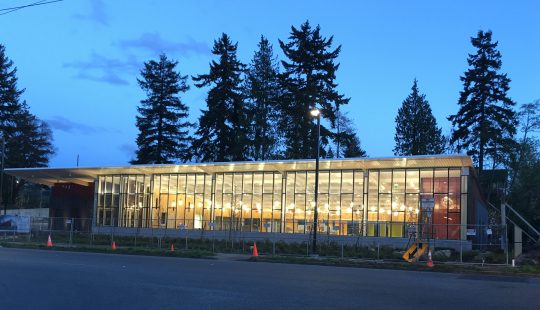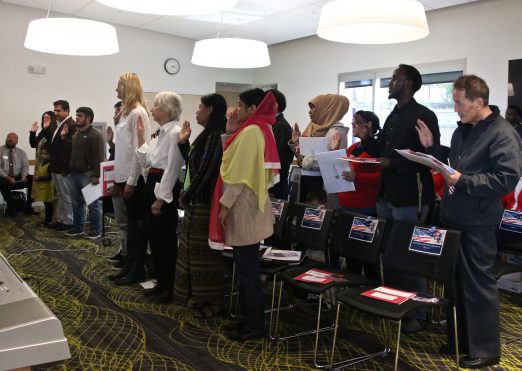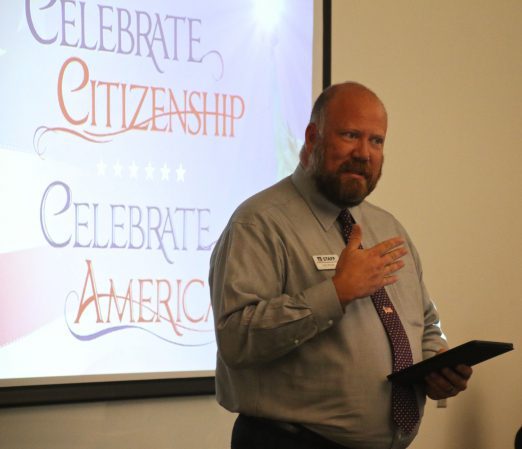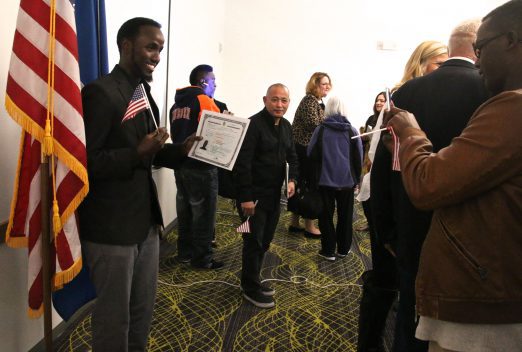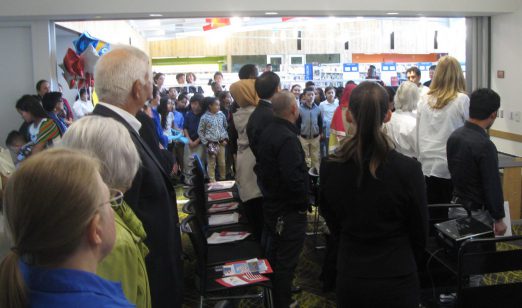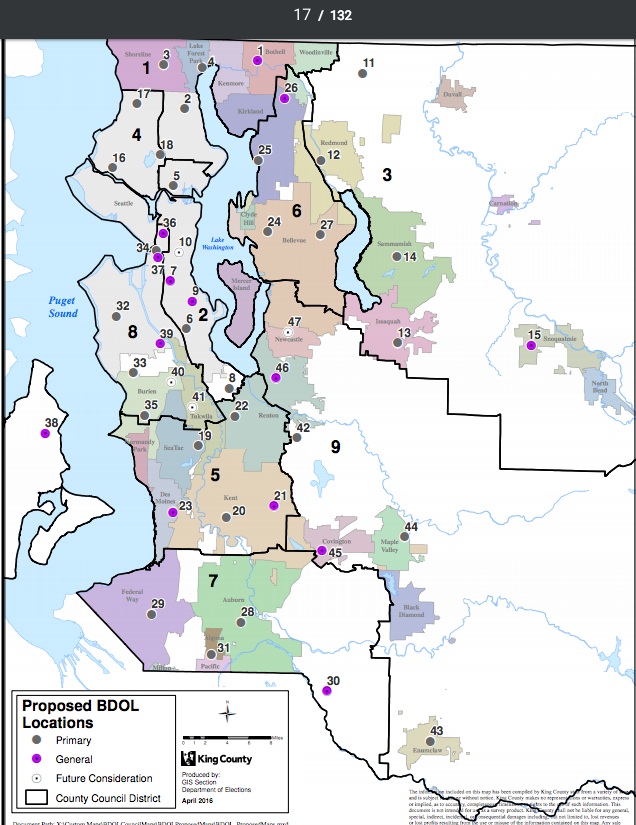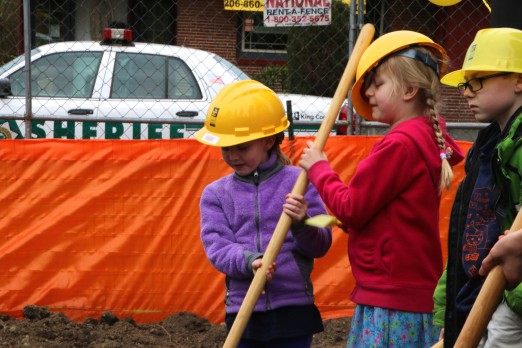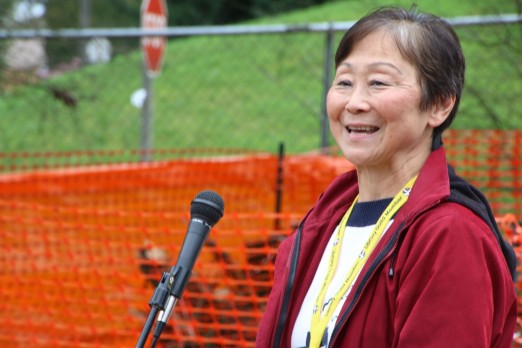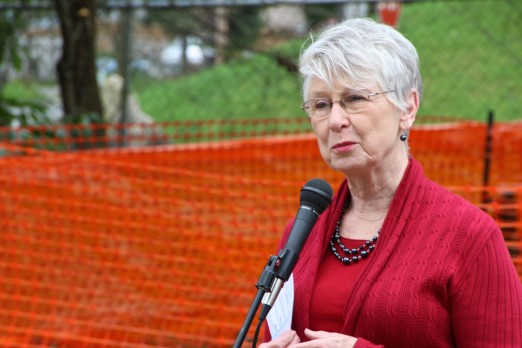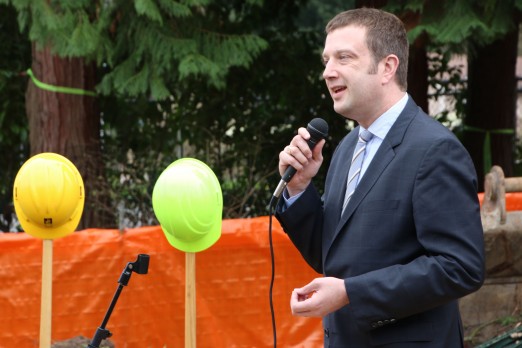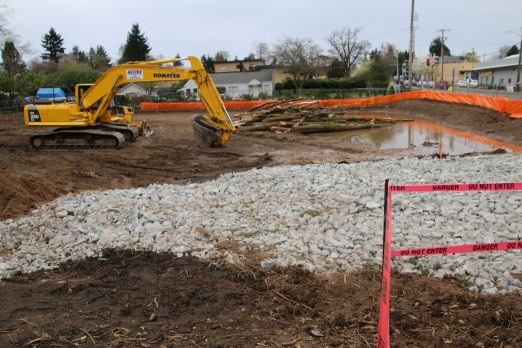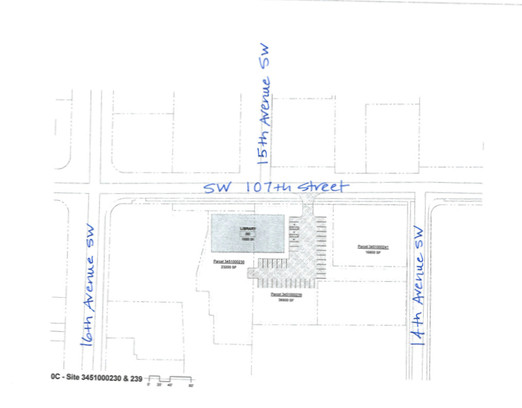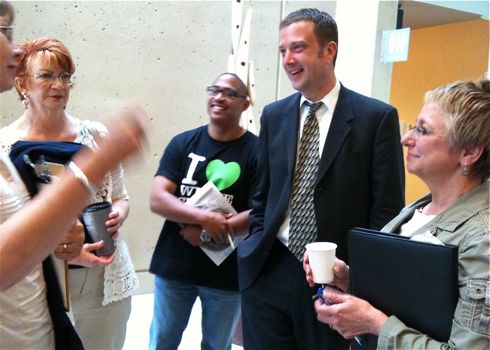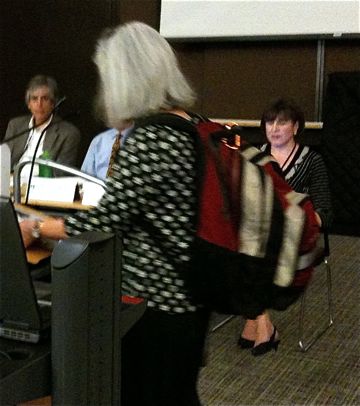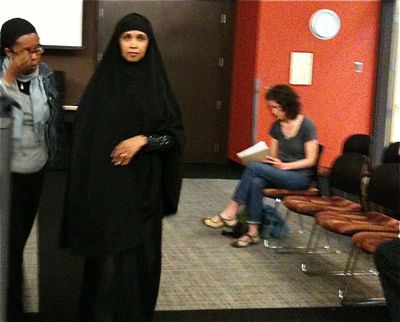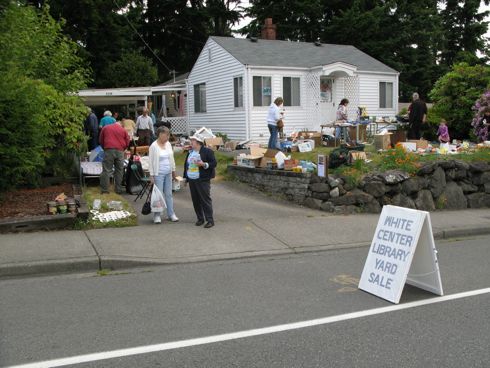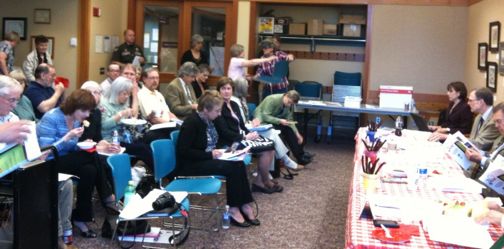By Tracy Record
White Center Now editor
The most intense discussion at tonight’s North Highline Unincorporated Area Council meeting was a side trip off the agenda and outside the county – the Myers Way campers, with and without vehicles, on City of Seattle-owned land right over the boundary.
But first, from the agenda – WC’s new library – and its role in the annexation debate:
NEW LIBRARY, AND ITS FUTURE IF SEATTLE ANNEXATION HAPPENS: New NHUAC president Liz Giba pronounced the new White Center Library “awesome.” KCLS executive director Gary Wasdin took centerstage right after that, declaring it a “wonderful space.” It’s now been almost two weeks since the dedication/ribboncutting (WCN coverage here). He quoted Rachael Levine of the White Center Library Guild – present at the NHUAC meeting too – who had said at the ceremony, “if you want to support the library, use it.” He said, “Every single step of the White Center Library has been driven by community.”
He acknowledged that “top of everybody’s minds” is the issue of annexation and what happens if White Center is annexed by Seattle. “Nothing has really happened” since last time he talked about it, he began. For one, he reminded everyone that KCLS also has a library in Greenbridge. “Should annexation (happen), a decision has to be made about the future of those (two) libraries … and whether they are King County libraries or Seattle Public libraries … To be perfectly fair, that’s not my decision to make.” It’s the community’s decision, he said. “We will support whatever decision is made and will make it work and will fight to make sure you have libraries. … As a reminder, there are basically two options … assuming annexation is approved and happens: Option 1, that SPL takes over operation of the libraries,” which he said would require “some kind of written agreement with the city of Seattle” including a commitment that they would remain libraries. Or “Option 2, Seattle contracts with King County Libraries” to operate them. “Why would you do that? Actually, there are pros and cons to both sides.” That includes the fact that library patrons would continue to be both city and unincorporated-area residents. “We have an agreement with SPL that (people can) interchangeably use both systems.”
As for finances – with the caveat that it’s his opinion – “I think it makes more sense for Seattle to contract with us. … Let’s say annexation takes place, you all stop paying the King County Library operating tax. … Seattle could opt to pay us for the lost tax revenue, to continue to operate the two libraries. The reason that’s a benefit to the city of Seattle is that the cost of operating them is far more than the tax revenue that is generated.” He says that likely wouldn’t and couldn’t be an indefinite agreement, “but it’s the option that we’ve floated … we’ve shared it with Kenny (Pittman, Seattle’s point person on annexation).” He again said the community ultimately needs to make the decision. And he suggested that those interest in this should share it “with anybody who will listen to you” – and that includes the Boundary Review Board, which has a two-day hearing on Seattle’s annexation proposal coming up in two weeks in White Center (he said KCLS will have two staff members at the hearing), June 13, 14 and possibly 16. “You have a little leverage here because they [Seattle] need a positive vote. … Libraries are different … You all paid for this library” – via levy – “so you should have a say in … what you think the future of that library should be.”
Wasdin said he hasn’t seen anything regarding the cost of “the physical act of annexation” – he alluded to a past agreement, now expired, that at one point had KCLS planning to pay Seattle to take the libraries, but that was before the current WC libraries were built. Now, “it would just be a transfer … obviously with a lot of logistics …” and that could be complicated, including the fact that the state owns the land on which the new library was built, Wasdin said. He said it’s around $2 million a year to operate the two libraries in WC. Getting things in writing are important, he said, given that whatever commitment elected officials make, there’s no guarantee they’ll be in office forever.
Wasdin also pointed out that for example, KCLS operates a library in downtown Seattle, in the Convention Center – operating its 49 libraries is NOT a matter of district boundaries.
“This is the cheaper option for them,” Wasdin reiterated, in terms of the decision to be made if annexation happens – but he said he doesn’t believe most layers of Seattle government, such as the mayor and council, have even thought about it yet.
Asked about the debt on the buildings, Wasdin said that the bond payment, through 2024, would continue, as far as he knows. He said that’s another argument for KCLS continuing to operate it even if the area is annexed – they’d still be paying it off.
What about the old White Center Library building? It’s been sold to West Seattle Montessori School – the deal hasn’t quite closed yet, said Wasdin. “That’s a very special building, sentimentally,” he added.
As Wasdin’s section of the agenda wrapped up, NHUAC board member Elizabeth Devine said she was looking forward to the new library’s air conditioning with the sizzling weather expected this weekend.
CRIME BRIEFING: Storefront deputy Bill Kennamer was at the meeting with the newest information on local crime trends. Here are the three sheets he circulated:
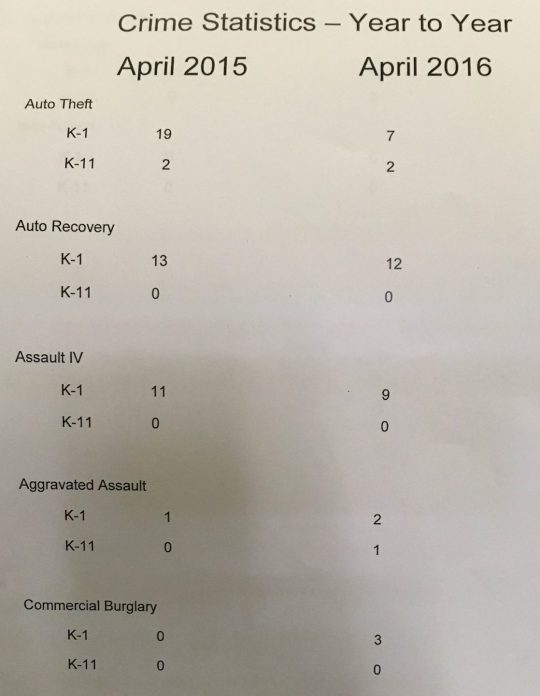
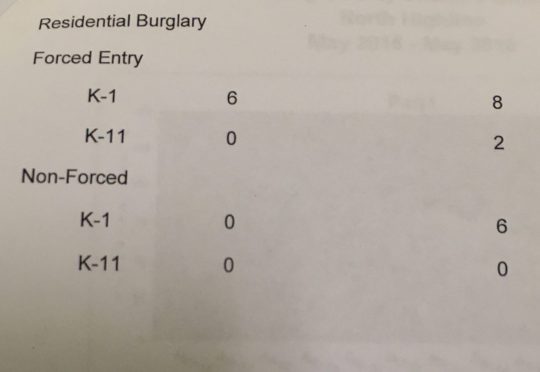
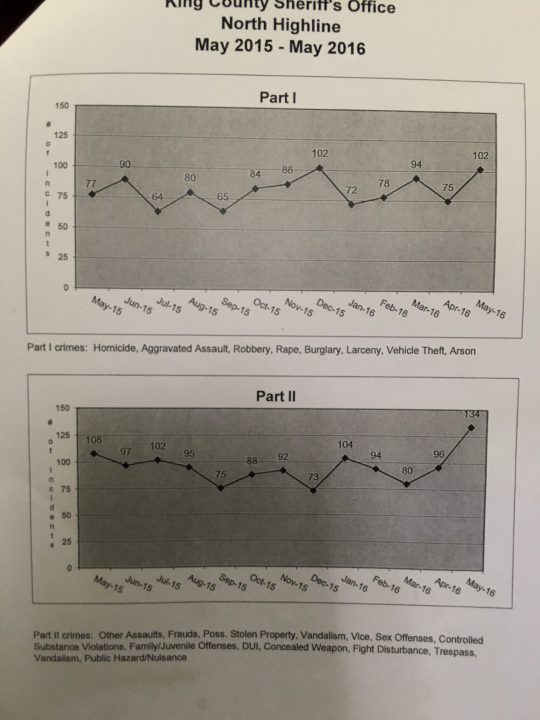
Auto theft is way down – though they’ve recovered more cars than were stolen locally (“stolen somewhere else and brought here”), said Deputy Kennamer. Burglaries “have spiked significantly,” and he thinks both the heroin-use epidemic and increase in people experiencing homelessness are to blame. A resident in the Myers Way area says the latter “is getting ugly … if we don’t do something about this, it’s going to drag the community down.” Another attendee said, “The police can’t handle all this … and it’s not just here, it’s everywhere.”
Deputy Kennamer says he’s frustrated too – “the only thing I can do is hassle people as they come and go, I can’t tow cars, I can’t call code enforcement” because the Myers Way site is in Seattle city limits. He also talked about the pollution that seemed to be happening on the land on the east side of Myers because of unauthorized encampments. Asked how many people are there, he suggested hundreds, and thought at least 11 RVs are currently camped by the entrance to the Myers Parcels on the west side of the street.
(If you don’t read our partner site – here’s the latest proposal for what the city might be doing with the land.)
Much discussion ensued with concern about whether Seattle Police are doing anything about the problem, and some alleging that the Seattle City Council has taken action or made statements somehow hindering SPD from doing anything.
Elizabeth Gordon of the NHUAC board suggested that perhaps the community could use this situation as leverage related to the ongoing annexation discussions, “basically something that says, ‘this is what we want if you want us to vote for annexation – that doesn’t guarantee we’ll vote for annexation but it sure might help,” perhaps requesting a city-county task force “to address the situation on Myers Way jointly,” among other things.
One attendee noted that it’s “not just a law-enforcement situation” and mentioned a model in San Francisco for how people experiencing homelessness are being helped, “not the model we have (here) now.”
NHUAC vice president Barbara Dobkin said in her view it’s a “Seattle problem” that the city is not addressing. Board member Devine said she’s worked with people experiencing substance abuse and it’s important not to “lump all the homeless” together, but it is important to take a look at those who are “a menace to our community” and ensure they are not “immune from the consequences of their behavior … (don’t just) say ‘the homeless’ and think we are covering it all.” Her voice broke as she spoke of someone who wound up along Myers Way because he was down on his luck, and got mugged and robbed by “predators.”
Deputy Kennamer said at that point that earlier in his law-enforcement career, people experiencing homelessness broke into three categories – substance-addled people who had burned all their bridges, people with mental illness, people running from the law. Now, he said, he is seeing a younger group of people who decide to live this way “and steal everything they can steal … and the vast majority … are drug addicts – that’s the group we have to aggressively police. … I spend the bulk of my day dealing with them, chasing them from one park to another park … but I’m not handcuffed. The Sheriff’s Office is not handcuffed.”
While he says “there’s drug dealing going on,” he says the days of meth labs in RVs appears to be over – it all comes from elsewhere.
Discussion meandered back to why people are on the streets, and one attendee pointed out that many have wound up there because of domestic violence. Board member Devine pointed out that services are available for DV survivors – that they could call 211 to seek resources.
Keep calling police, Deputy Kennamer advised, as well as political pressure – “show up at the King County Council meeting – you have a voice.”
The talk then circled back to an attendee wondering if there could be a regional way to examine the problem. “We are talking about human beings living in a region, and we should be looking at a way to deal with it rather than just looking from one place to the next.”
Toward the end of the discussion, Kennamer pointed out that the shortage of law-enforcement resources leads to a shortage of ability to be proactive. And improvement isn’t on the horizon – he said a recent meeting included information that the department is almost $4 million short, which could mean no air and sea resources.
Meantime, Deputy Kennamer said September 1st is the target date for the White Center storefront to move from 16th SW to its new home at Steve Cox Memorial Park.
After he left the front of the room, NHUAC president Giba worried aloud that the Myers situation did not portend well for how Seattle would treat this area if annexed. But she expressed hope for working in collaboration with Highland Park and South Park – “they are our neighbors.” Meantime, though, she noted that King County government is the current government of this area and needs to be pressured to protect the area from being abused.
ANNEXATION CODA: Before meeting’s end, annexation came up again, with the aforementioned Boundary Review Board hearings looming. NHUAC president Giba said that what’s needed right now is information from Seattle – “be straight with us.”
COMMUNITY SERVICE AREA MEETING: President Giba gave a recap of the recent annual North Highline Community Service Area meeting at Seola Gardens; among other observations, she said it was disappointing that this area’s King County Councilmember, Joe McDermott, wasn’t there. “It was shocking that our councilmember wasn’t there,” said NHUAC board member Dominic Barrera. One top county official who was there, Sheriff John Urquhart, drew kudos for his presence and presentation.
COMMUNITY ANNOUNCEMENTS: Gill Loring announced the work party this Saturday, 9 am-1 pm, at North Shorewood Park (see our earlier announcement for details) … Another attendee announced June 9-10, 1-4 pm, car wash at New Start High School … The King County Council committee’s next hearing on proposed marijuana rules is coming up at 9 am June 16th, said Mark Johnston, who’s been a community watchdog on the issue, saying anyone with concerns about marijuana zoning in unincorporated King County should “speak up” – public comment will be part of that meeting … Another attendee noticed a sign up for a new affordable-housing project at 1st and 112th in Top Hat, almost 300 residential units and 38,000 square feet of commercial space. (We’re researching this right now and will have a separate followup.) … White Center Kiwanis‘s annual Jubilee Days pancake breakfast is coming up … Petitions for Initiative 1491, allowing a family member to petition the court to “suspend access to a firearm of a loved one who has become a danger to himself and/or others,” were brought to the meeting … A part-owner of the Highline Bears was on hand to make sure NHUAC knew about the team, with home games at Steve Cox Memorial Park the next three Friday nights, 7:05 pm.
The North Highline Unincorporated Area Council meets first Thursdays, 7 pm, but will be on hiatus now until September, when the county Comprehensive Plan will be on the agenda – watch northhighlineuac.org for updates. You’ll also see board members at the aforementioned Boundary Review Board hearing – again, here’s the notice for that hearing, set for two days and possibly a third.
